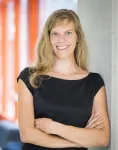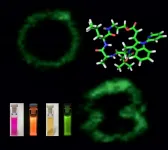(Press-News.org) The concrete world that surrounds us owes its shape and durability to chemical reactions that start when ordinary Portland cement is mixed with water. Now, MIT scientists have demonstrated a way to watch these reactions under real-world conditions, an advance that may help researchers find ways to make concrete more sustainable.
The study is a "Brothers Lumière moment for concrete science," says co-author Franz-Josef Ulm, professor of civil and environmental engineering and faculty director of the MIT Concrete Sustainability Hub, referring to the two brothers who ushered in the era of projected films. Likewise, Ulm says, the MIT team has provided a glimpse of early-stage cement hydration that is like cinema in Technicolor compared to the black and white photos of earlier research.
Cement in concrete contributes about 8 percent of the world's total carbon dioxide emissions, rivaling the emissions produced by most individual countries. With a better understanding of cement chemistry, scientists could potentially "alter production or change ingredients so that concrete has less of an impact on emissions, or add ingredients that are capable of actively absorbing carbon dioxide," says Admir Masic, associate professor of civil and environmental engineering.
Next-generation technologies like 3D printing of concrete could also benefit from the study's new imaging technique, which shows how cement hydrates and hardens in place, says Masic Lab graduate student Hyun-Chae Chad Loh, who also works as a materials scientist with the company Black Buffalo 3D Corporation.
Loh is the first author of the study published in ACS Langmuir, joining Ulm, Masic, and postdoc Hee-Jeong Rachel Kim.
Cement from the start
Loh and colleagues used a technique called Raman microspectroscopy to get a closer look at the specific and dynamic chemical reactions taking place when water and cement mix. Raman spectroscopy creates images by shining a high-intensity laser light on material and measuring the intensities and wavelengths of the light as it is scattered by the molecules that make up the material.
Different molecules and molecular bonds have their own unique scattering "fingerprints," so the technique can be used to create chemical images of molecular structures and dynamic chemical reactions inside a material. Raman spectroscopy is often used to characterize biological and archaeological materials, as Masic has done in previous studies of nacre and other biomineralized materials and ancient Roman concretes.
Using Raman microspectroscopy, the MIT scientists observed a sample of ordinary Portland cement placed underwater without disturbing it or artificially stopping the hydration process, mimicking the real-world conditions of concrete use. In general, one of the hydration products, called portlandite, starts as a disordered phase, percolates throughout the material, and then crystallizes, the research team concluded.
Before this, "scientists could only study cement hydration with average bulk properties or with a snapshot of one point in time," says Loh, "but this allowed us to observe all the changes almost continuously and improved the resolution of our image in space and time."
For instance, calcium-silicate-hydrate, or C-S-H, is the main binding ingredient in cement that holds concrete together, "but it's very difficult to detect because of its amorphous nature," Loh explains. "Seeing its structure, distribution, and how it developed during the curing process was something that was amazing to watch."
Building better
Ulm says the work will guide researchers as they experiment with new additives and other methods to reduce concrete's greenhouse gas emissions: "Rather than 'fishing in the dark,'" we are now able to rationalize through this new approach how reactions occur or do not occur, and intervene chemically."
The team will use Raman spectroscopy as they spend the summer testing how well different cementitious materials capture carbon dioxide, Masic says. "Tracking this up to now has been almost impossible, but now we have the opportunity to follow carbonation in cementitious materials that helps us understand where the carbon dioxide goes, which phases are formed, and how to change them in order to potentially use concrete as a carbon sink."
The imaging is also critical for Loh's work with 3D concrete printing, which depends on extruding concrete layers in a precisely measured and coordinated process, during which the liquid slurry turns into solid concrete.
"Knowing when the concrete is going to set is the most critical question that everyone is trying to understand" in the industry, he says. "We do a lot of trial and error to optimize a design. But monitoring the underlying chemistry in space and time is critical, and this science-enabled innovation will impact the concrete printing capabilities of the construction industry."
This work was partially supported by the scholarship program of the Kwanjeong Educational Foundation.
INFORMATION:
Written by Becky Ham, MIT News correspondent
Paper: "Time-space-resolved chemical deconvolution of cementitious colloidal systems using Raman spectroscopy"
https://pubs.acs.org/doi/10.1021/acs.langmuir.1c00609
A new technology could dramatically improve the safety of lithium-ion batteries that operate with gas electrolytes at ultra-low temperatures. Nanoengineers at the University of California San Diego developed a separator--the part of the battery that serves as a barrier between the anode and cathode--that keeps the gas-based electrolytes in these batteries from vaporizing. This new separator could, in turn, help prevent the buildup of pressure inside the battery that leads to swelling and explosions.
"By trapping gas molecules, this separator can function as a stabilizer for volatile electrolytes," said Zheng Chen, a ...
To describe something as slow and boring we say it's "like watching grass grow", but scientists studying the early morning activity of plants have found they make a rapid start to their day - within minutes of dawn.
Just as sunrise stimulates the dawn chorus of birds, so too does sunrise stimulate a dawn burst of activity in plants.
Early morning is an important time for plants. The arrival of light at the start of the day plays a vital role in coordinating growth processes in plants and is the major cue that keeps the inner clock of plants in rhythm with day-night cycles.
This inner circadian clock helps plants prepare for the day such as when to make the best use of sunlight, the best time to open flowers ...
Citizen opposition to COVID-19 vaccination has emerged across the globe, prompting pushes for mandatory vaccination policies. But a new study based on evidence from Germany and on a model of the dynamic nature of people's resistance to COVID-19 vaccination sounds an alarm: mandating vaccination could have a substantial negative impact on voluntary compliance.
Majorities in many countries now favor mandatory vaccination. In March, the government of Galicia in Spain made vaccinations mandatory for adults, subjecting violators to substantial fines. Italy has made vaccinations mandatory for care workers. The University of California and California State University systems announced in late April that vaccination ...
ITHACA, N.Y. - Building lights are a deadly lure for the billions of birds that migrate at night, disrupting their natural navigation cues and leading to deadly collisions. But even if you can't turn out all the lights in a building, darkening even some windows at night during bird migration periods could be a major lifesaver for birds.
Research published this week in PNAS found that over the course of 21 years, one building sustained 11 times fewer nighttime bird collisions during spring migration and 6 times fewer collisions during fall migration when only half of the building's windows were illuminated, compared ...
Many mainstream depictions of immigration at the southern border of the United States paint a dark picture, eliciting imagery of violent gang members and child trafficking. But how many undocumented immigrants are really involved in this kind of activity? Many people may be surprised to learn the answer is far fewer than they think.
A new study from the Peace and Conflict Neuroscience Lab (PCNL) at the Annenberg School for Communication found that Americans dramatically overestimate the number of migrants affiliated with gangs and children being trafficked, and that this overestimation contributes to dehumanization of migrants, lack of empathy for their suffering, and individuals' views on immigration policy. In addition, the researchers developed and tested interventions to ...
Brazilian researchers have simultaneously demonstrated the mechanism linking high blood pressure to elevated intracranial pressure, validated a non-invasive intracranial pressure monitoring method, and proposed a treatment for high blood pressure that does not affect intracranial hypertension.
The study was supported by FAPESP and involved collaboration between researchers at São Paulo State University (UNESP) and Brain4care, a startup based in São Carlos. It could result in novel treatments for intracranial hypertension and its complications, including stroke. The main findings are reported in the journal Hypertension.
The researchers monitored blood pressure and intracranial pressure in rats for six weeks. “We set out to investigate ...
Biomolecules regulate the biological functions inside every living cell. If scientists can understand the molecular mechanisms of such functions, then it is possible to detect the severe dysfunction which can lead to illness. At a molecular level, this can be achieved with fluorescent markers that are specifically incorporated into the respective biomolecules. In the past, this has been achieved by incorporating a marker in the bio-molecule by completely rebuilding it from the beginning, necessitating a large number of steps. Unfortunate-ly, this approach not only takes a lot of time and resources, but also produces unwanted waste products. Researchers at the Universities of Göttingen and Edinburgh have now ...
If you're a beer drinker, you've noticed that hoppy beers have become increasingly popular. Most of the nation's hops come from the Pacific Northwest. However, commercial hop production regions have expanded significantly. In Michigan hop production nearly tripled between 2014 and 2017 and in 2019, Michigan growers harvested around 720 acres of hops.
Michigan hop growers contend with unique challenges as a result of frequent rainfall and high humidity during the growing season. In 2018, growers approached Michigan State University researchers and the Michigan State University's Plant & Pest Diagnostics lab with concerns about a leaf blight ...
ORLANDO, June 2021 - A new study co-authored by University of Central Florida researchers shows that pre-Columbian people of a culturally diverse but not well-documented area of the Amazon in South America significantly altered their landscape thousands of years earlier than previously thought.
The findings, published in the journal Proceedings of the National Academy of Sciences, show evidence of people using fire and improving their landscape for farming and fishing more than 3,500 years ago. This counters the often-held notion of a pristine Amazon during pre-Columbian times before the arrival of Europeans in the late 1400s.
The study, ...
Climate change and social inequality are two pressing issues that often overlap. A new study led by Princeton researchers offers a roadmap for cities to address inequalities in energy use by providing fine-grained methods for measuring both income and racial disparities in energy use intensity. Energy use intensity, the amount of energy used per unit floor area, is often used as a proxy for assessing the efficiency of buildings and the upgrades they receive over time. The work could guide the equitable distribution of rebates and other measures that decrease energy costs and increase efficiency.
Examining inequality in cities has been hampered ...








